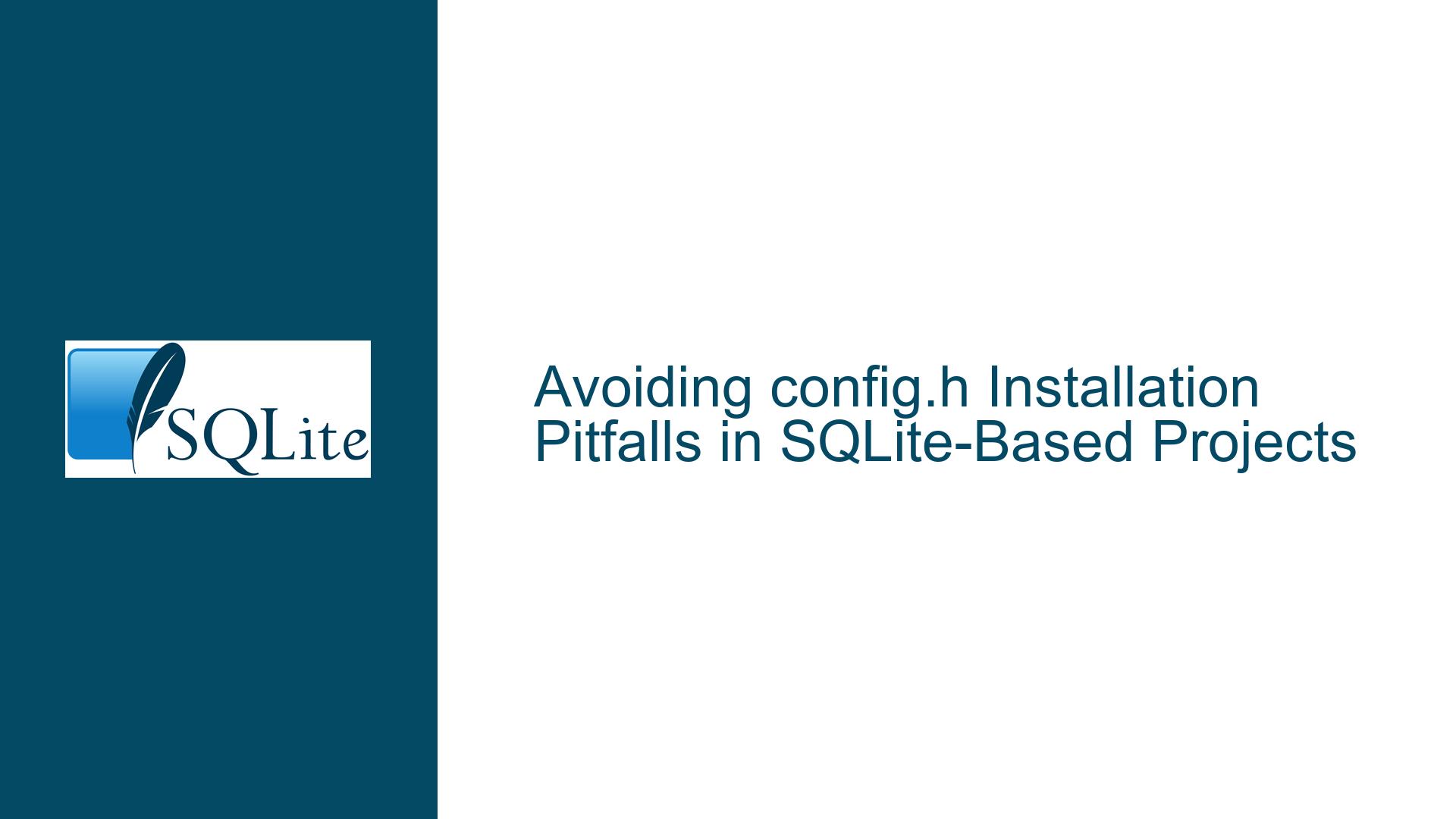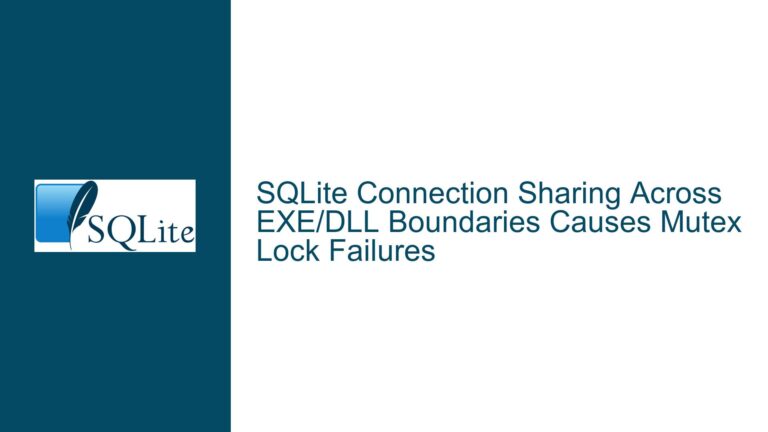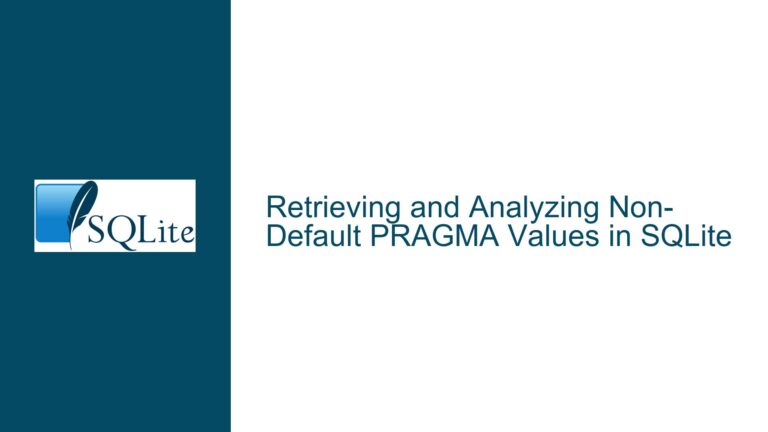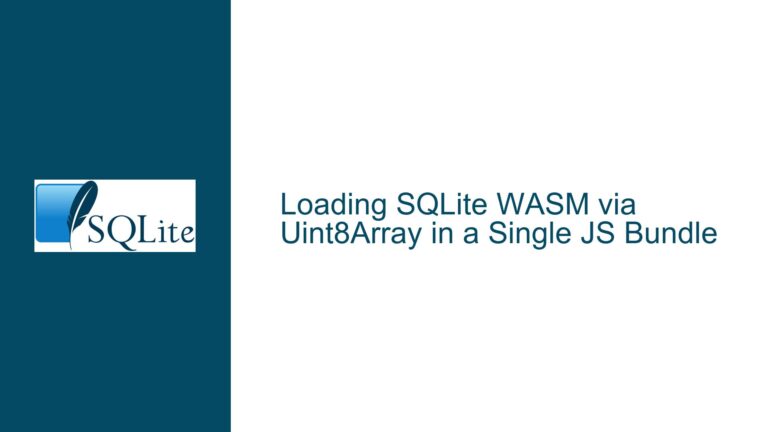Avoiding config.h Installation Pitfalls in SQLite-Based Projects
The Perils of Publicly Exposed config.h in Build Systems
When working with SQLite or projects leveraging its codebase, one of the most insidious sources of build errors, runtime instability, and dependency conflicts stems from improper handling of the config.h header file. This file, typically generated during the build configuration phase (e.g., via Autoconf or CMake), contains system-specific macros and definitions critical for compiling the project correctly. However, the act of installing this file into public include directories or distributing it across components creates a cascade of problems that violate the One Definition Rule (ODR) in C/C++, introduce version mismatches, and destabilize multi-component architectures. This guide dissects the root causes, implications, and mitigation strategies for these issues, with a focus on SQLite’s ecosystem and lightweight database systems.
Why config.h Installation Breaks Builds and Invokes "Dependency Hell"
1. Violation of the One Definition Rule (ODR)
The config.h file defines preprocessor macros that customize the behavior of the codebase for a specific build environment. When this file is installed into a global include path (e.g., /usr/include), multiple components or libraries may inadvertently include conflicting versions of config.h. For example, if SQLite’s config.h defines HAVE_USLEEP=1 and another library’s config.h undoes this, the compiler may inline incompatible logic into different translation units, leading to undefined behavior or silent data corruption.
2. Build System Coupling and Version Stasis
Installing config.h assumes that the build environment’s configuration will remain static across all future uses. However, software updates, cross-compilation scenarios, or changes to system libraries can render the installed config.h obsolete. In SQLite, which emphasizes portability and embedded use, a stale config.h might misdetect threading APIs (e.g., opting for pthreads instead of the correct Win32 threads on a newer Windows subsystem), causing crashes or performance degradation.
3. Namespace Pollution and Dependency Conflicts
Projects that depend on SQLite as a library may themselves rely on other components that ship their own config.h. When both headers are exposed in the include search path, the preprocessor may pick the wrong file due to case-insensitive filesystems, symlink ambiguities, or incorrect -I flag ordering. This is particularly problematic in environments where case sensitivity varies (e.g., macOS’s default filesystem vs. Linux), leading to "file not found" errors or silent inclusion of unrelated headers.
4. Improper Distribution Packaging
Some package managers or build scripts inadvertently bundle config.h into distribution tarballs or binary packages. When users install these packages, the file becomes globally visible, "infecting" subsequent builds of other software. For instance, a SQLite config.h packaged with a Linux distribution’s libsqlite3-dev could override a project’s internal configuration when compiling against both SQLite and another library with its own config.h.
Strategies to Eliminate config.h-Related Build Failures and Runtime Errors
1. Treat config.h as a Private Build Artifact
The primary rule is to treat config.h as a private, non-installable file. This requires modifying build scripts to ensure the header is neither copied to public include directories nor included in distribution packages.
Autoconf/Automake: In
Makefile.am, override theinstall-data-localtarget to excludeconfig.h. Usenodist_include_HEADERSto avoid distributing generated headers.nodist_include_HEADERS = # Leave empty to exclude config.h install-data-local: $(INSTALL) -d $(DESTDIR)$(includedir)/private $(INSTALL) -m 644 config.h $(DESTDIR)$(includedir)/privateThis installs
config.hinto aprivatesubdirectory, reducing collision risks.CMake: Use
target_include_directorieswith thePRIVATEscope to restrictconfig.hvisibility.configure_file(config.h.in config.h) add_library(sqlite STATIC sqlite3.c) target_include_directories(sqlite PRIVATE ${CMAKE_CURRENT_BINARY_DIR})This ensures that only the library’s source files see
config.h, not downstream consumers.
2. Namespace config.h with Project-Specific Prefixes
If config.h must be exposed (e.g., for unit tests), rename it to a project-unique header like sqlite_config.h and update all source files to reference this name. This avoids clashes with other config.h files in the include path.
Autoconf: Modify
configure.acto generate a project-specific header.AC_CONFIG_HEADERS([sqlite_config.h])In code, include
#include "sqlite_config.h"instead ofconfig.h.Preprocessor Guards: Add inclusion guards tied to the project’s namespace.
#ifndef SQLITE_CONFIG_H #define SQLITE_CONFIG_H /* ... contents ... */ #endif
3. Isolate config.h in Build-Specific Directories
Instead of placing config.h in a global or project-wide include directory, keep it in a build-output subdirectory (e.g., build/include) and reference it via relative paths.
Compiler Flags: Pass the build directory as an include path only when compiling the project itself.
gcc -I$(pwd)/build/include -c sqlite3.cDownstream users will not have this path in their
-Iflags, preventing accidental inclusion.Build System Sandboxing: Tools like Bazel or Meson can enforce strict isolation between a project’s internal headers and external dependencies. For SQLite, a
meson.buildsnippet might look like:config_h = configure_file(input: 'config.h.in', output: 'sqlite_config.h', configuration: conf_data) sqlite_lib = static_library('sqlite', 'sqlite3.c', install: true, include_directories: include_directories('.'))Here,
sqlite_config.his only visible within the library’s build context.
4. Use Pimpl (Pointer to Implementation) for ABI Stability
For libraries that expose APIs dependent on config.h settings, hide implementation details behind an opaque struct. This reduces the need for client code to include configuration headers.
Header File:
// sqlite_public.h typedef struct sqlite_impl sqlite_impl; sqlite_impl* sqlite_create(); void sqlite_use_feature(sqlite_impl*, int param);Implementation File:
#include "sqlite_config.h" struct sqlite_impl { int config_option; }; sqlite_impl* sqlite_create() { sqlite_impl* p = malloc(sizeof(*p)); p->config_option = SQLITE_CUSTOM_CONFIG; return p; }Clients only interact with the opaque pointer, avoiding exposure to
SQLITE_CUSTOM_CONFIGdefined insqlite_config.h.
5. Validate config.h Isolation in CI/CD Pipelines
Add automated checks to ensure config.h does not leak into public headers or installed directories.
Static Analysis: Use
greporsedin CI scripts to scan installation directories forconfig.h.if find $INSTALL_DIR -name config.h | grep -q '.'; then echo "config.h detected in installation!" >&2 exit 1 fiSymbol Visibility Tests: Compile a test program that includes SQLite’s public headers and attempts to reference
config.h-specific macros. If the build succeeds, it indicates leakage.#include <sqlite3.h> #ifdef HAVE_USLEEP #error "config.h macro exposed!" #endifTrigger a compilation failure if such macros are visible.
Advanced Mitigation: Alternatives to config.h in Modern Build Systems
1. Compiler-Default Macros via Command Line
Instead of generating a config.h file, pass configuration macros directly to the compiler using -D flags. This avoids the need for a physical header file.
Autoconf: In
configure.ac, replaceAC_CONFIG_HEADERSwith:AC_DEFINE([HAVE_USLEEP], [1], [Description])This injects
-DHAVE_USLEEP=1intoCFLAGS, eliminatingconfig.h.CMake: Use
target_compile_definitionsto propagate macros.target_compile_definitions(sqlite PRIVATE HAVE_USLEEP=1)
2. Unity Builds and Precompiled Headers
Consolidate all source inclusions into a single translation unit or precompiled header that includes config.h once, reducing the chance of conflicting definitions.
Unity Build Script:
echo '#include "sqlite3.c"' > sqlite_unity.c gcc -Isrc -DHAVE_USLEEP=1 -c sqlite_unity.cPrecompiled Header (PCH):
// pch.h #include "config.h" #include "sqlite3.h"Compile with
-include pch.hto ensureconfig.his included uniformly.
3. Feature Detection at Runtime
For settings that can be determined dynamically (e.g., byte order, threading support), replace preprocessor macros with runtime checks.
- Example:
#ifndef HAVE_USLEEP static bool has_usleep() { /* Runtime detection logic */ } #endifThis reduces reliance on compile-time configuration.
By rigorously applying these strategies, developers can sidestep the "dependency fun" that arises from mishandling config.h, ensuring robust builds and consistent behavior across SQLite-based projects. The key lies in treating configuration headers as transient, private artifacts tied to a specific build context—never as installable, shareable resources.






